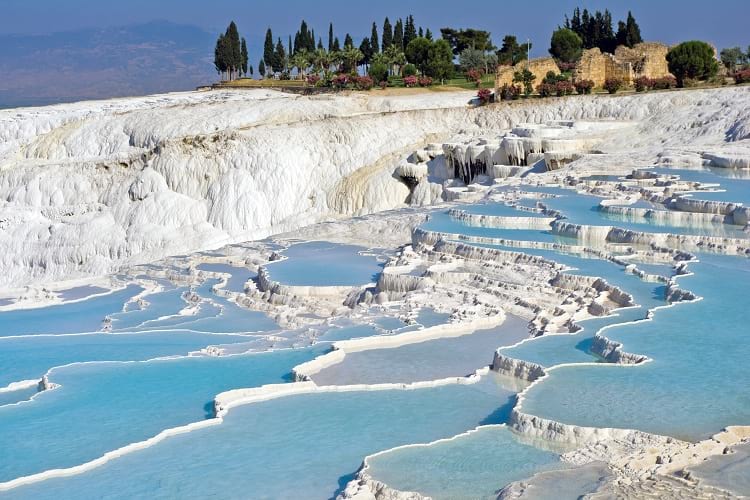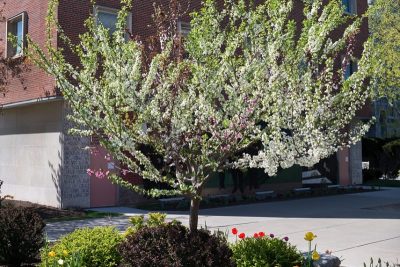Pamukkale: The Cotton Castle in a Mess of Limestone and Healing Waters
Share

Pamukkale or Cotton Castle. (Antoine Taveneaux / Wikimedia Commons)
She made history with her beauty and brain. And patronizing a place which would become a popular tourist jaunt. Welcome to Cleopatra’s Antique Pool, where the Egyptian Queen, Cleopatra (69-30 BCE), known for her penchant for health and beauty, spent quality time in the hot springs. The pool is one of the 17 water bodies located at Pamukkale (meaning cotton castle) in the Denizli province of the Republic of Turkey. It is a scenic spread of dazzling white calcium carbonate in 8860 ft. X 1,970 ft X 525 ft. Verily called ‘spa town’, Pamukkale is a health cum healing joint in the valley of river Menderes. It is a medley of slabs, pillars and caves made of calcium compounds. The name cotton castle comes from a legend that bales of cotton were spread out to dry in open. But, in time, these mutated to the present day limestones. A tad realistic as the cotton is the principal agriculture crop of the area.

Pamukkale, Turkey. (Katie Hunt / Flickr)
Created by the natural forces of hot water springs and earthquakes
The formation of the cotton castle is a handiwork of 2 elements, water and earth. Hot water springs flow out from bowels of the earth. Their waters are supersaturated with minerals, which precipitate as water spreads on the uneven ground to find its base. The precipitate settles into terrace formations. Carbon-di-oxide (gas) disengages from the mixture and escapes into the open air. Some of the gas is trapped in the mass of precipitate that falls on the wayside, on cliffs and slopes, creating calcium bubbles. From distance, the bubbles look like fluffs of cotton on limestone slabs (travertines) and pillars (stalactites). Amid these white and shining terraces, some caves are also formed in a natural way. The air in the caves is flushed with carbon dioxide and these were used for religious purpose in ancient times.
Pamukkale: A historical site, health resort, and religious hub
The site, back in 190 BC, was a holy city called Hierapolis. It was a place known for sacred rites and spiritual pursuits, as well as for curing of diseases with mineral rich hot water springs. Frequented by the royalty, including the Egyptian Queen Cleopatra, it was famed as the retirement retreat for the Roman Kings. Two massive earthquakes, one in 60 AD and another in 1334 AD ravaged this historic city. Nevertheless, the ruins of the city add to the overall charisma of Pamukkale as a picnic spot. The ruins are a key component of ‘Cotton Castle’ which was declared the world heritage site by UNESCO in 1988. Rubbles of buildings, the sediment of calcium terraces from hot mineral water, collection of spring water in pools of varying depths and size; all added to make natural upheavals into a piece of fine art. Among the relics dotting the cotton castle, Hierapolis theatre with its VIP boxes, 2 tier seating and niche compartments, a devious church, graveyard, city walls and pathways are noteworthy.
Hotels and approach roads planned to protect the site’s natural formation
With the reputation Pamukkale, as an excursion cum historical site spreading far and wide, in the year 1960, hotels and approach roads were built within and outside of it. The construction within was found detrimental to the Travertines and water pools. Hence it was demolished. Further, laws were enacted to ensure that water from pools is not misused by the hotels, but made available of tourist for bathing and excursion.
Surprises galore for the visitors
Karahayit hot spring, another attraction at Pamukkale, is a maze of coloured water. The colour reflected in water is decided by the nature of dissolved oxide in it. Located 5 km away from Pamukkale, the water of these springs may be up to 55° Celsius hot.
A visit to Pamukkale is an out-of-this-world-experience. Trekking barefoot on shining terraces, sitting on the poolside, bathing or simply splashing in mineral water, with temperature ranging upward of 35° Celsius, is a magical feeling. Bathing is generally safe. Water is drowning deep only in some places, and provisions are made to attend to emergencies. The ground can be slippery and limestone can have sharp edges; so caution is advised.
Paraglide for a bird’s eye view
Want to watch the whole thing from the sky? You can, thanks to the paragliding facilities available. A walk through the Pamukkale Nature Park can be your sneak peek into local customs, as the place is popular for its wedding ceremonies. For boating in the lake, and being one with hordes of ducks out there, you can hire a paddle boat and have your heart’s fill.
Enjoyed this article? Also, check out “Clear Water Lagoons and Pristine White Sand Dunes of Lençóis Maranhenses National Park“.
Fact Analysis:
STSTW Media strives to deliver accurate information through careful research. However, things can go wrong. If you find the above article inaccurate or biased, please let us know at [email protected]













